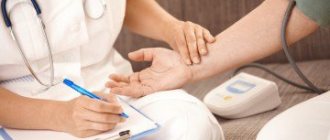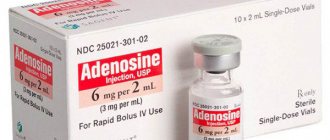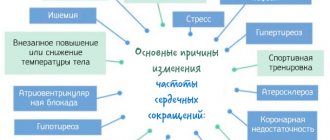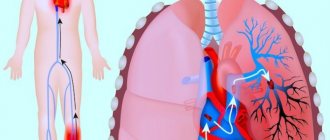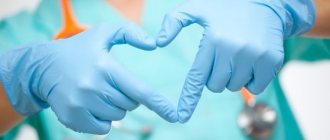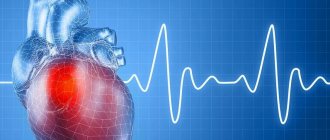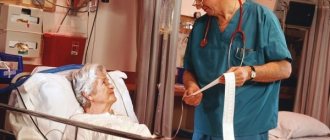Neuroses and neuralgia are the cause of many diseases, including neurological arrhythmia. Neurologists probably know whether this condition is dangerous. At the same time, it is advisable for every person prone to psycho-emotional agitation to be aware of ways to prevent this pathology.
“All diseases come from nerves” is a well-known saying. And it is not unfounded, since nerve endings connect to all organs without exception. The heart is especially sensitive to various types of nervous disorders. Under severe stress and emotional stress, its activity may be disrupted, and it’s good if everything forms on its own. But in some cases, neurological arrhythmias occur, which bring significant discomfort to a person.
Quite healthy people may experience several arrhythmias per day. But at the same time, they do not cause any changes in the general condition of a person.
Some people have a mentality that is especially susceptible to various nervous disorders. Minor stress or worries make them clutch at their hearts. Some might think this is fake. In fact, a person begins to have an attack of arrhythmia and in such cases appropriate assistance should be provided. Moreover, such a condition can be observed not only in old age, but also in young people.
Video Arrhythmia: If I’m young, then I can’t have arrhythmia?
Description of neurological arrhythmia
Arrhythmia should be understood as a rhythm disturbance that differs from normal sinus rhythm. In a healthy state, it is expressed in an adult heart rate of 60 to 90 times per minute, as well as a regular and regular heartbeat wave. If the heart is affected by unfavorable factors, then the rhythm and frequency are disturbed and arrhythmia is observed.
According to the nature of their severity, arrhythmias can be either frequent or rare, with an increase or, conversely, a decrease in heart rate. When the conduction system is involved in the pathological process, blockades of cardiac activity may occur.
The key mechanism for the development of arrhythmias is a violation of the basic functions of the heart: impulse conduction, myocardial contraction, excitation and refractoriness of cardiomyocytes. Since the heart is richly innervated, increases and decreases in heart rate are often associated with the activity of certain nerve fibers:
- the vagus nerves inhibit cardiac activity;
- the sympathetic nervous system increases the output and speeds up the rhythm.
The influence of the vagus and sympathetic nerves is interconnected, therefore, when the former are excited, the activity of the latter decreases and vice versa.
Treatment of neuralgia
Treatment of the disease begins with reducing pain, then eliminating the cause that caused the negative symptoms. You need to lie down during therapy. The mattress should be firm, ideally orthopedic. For drug therapy the following are used:
Additional treatments:
- Exercise therapy (therapeutic gymnastics).
- Massage speeds up recovery, helps restore normal blood supply, relaxes muscles, and improves the conduction of impulses along the nerves.
- Acupuncture alleviates the condition, reduces pain, and relieves muscle spasms.
Additionally, physiotherapy methods are prescribed:
- UHF;
- reflexology;
- treatment with vacuum or magnets;
- pharmacopuncture with drug administration;
- novocaine iontophoresis;
- laser therapy.
Treatment with paraffin, mud, and darsonvalization is also used. However, all additional methods are used only after pain has been eliminated. If neuralgia appears against the background of cancer, then the oncologist deals with the treatment.
Symptoms of neurological arrhythmia
Basically, in patients with neurological arrhythmia, symptoms occur suddenly, several times a day or from time to time. Often the symptoms of the disease are presented in the following sequence:
- palpitations appear;
- there are interruptions in the functioning of the heart;
- feeling weak;
- the heart “jumps out of the chest”;
- “darkens” in the eyes.
Against the background of such sensations, fear for their health and life in general develops, so patients turn to a cardiologist. In fact, such conditions are treated by cardiologists together with neurologists. Only then can a positive result in the treatment of neurological arrhythmia be achieved.
In 50% of patients with neurological arrhythmia, a disturbed perception of reality is noted when a person indicates, for example, a rapid pulse, but such a violation is not detected during testing.
A constant feeling of fear makes a person depressed. The patient may withdraw into himself and become less social. If he did manage to get an appointment with a doctor, he describes his experiences colorfully and in as much detail as possible. In general, arrhythmia brings more psychological discomfort than physical discomfort. In the presence of serious disorders associated with organic pathology, neurological arrhythmias such as fibrillation or flicker occur, which pose a danger to humans.
Remedy for vegetative-vascular dystonia
Rupture of the heart, blood vessels and other things.
Since many of those suffering from VSD believe that they are under constant threat of “rupture” of the heart and blood vessels, we apparently need to clarify this issue. However, the most accurate and short summary in this case sounds very simple: “Bullshit!” If the vessel is not affected by atherosclerosis, if the heart has not yet experienced a single heart attack, if, finally, the blood pressure does not exceed 200, then expecting their rupture is a thankless task. And in people who have been diagnosed with vegetative-vascular dystonia, everything is completely fine with atherosclerosis and hypertension - they simply do not exist.
At the same time, those suffering from VSD often “feel” that a vessel in their head or heart has either “already burst,” or “is about to burst,” or “should burst.” But the whole point is that they “feel” it! Here is the trick: a person simply physically cannot feel how a vessel “burst” in his head. We are only able to perceive the consequences of this misfortune, for example, stroke paralysis, but not the process. There are no receptors in the walls of blood vessels that perceive the state of this vessel! Whether he shrank or didn’t shrink, you can neither know nor feel! In other words, there are no sensors in the vessels that indicate their condition, and therefore all our “sensations” of this kind are fiction. In the same way, our “heartbeat” is to a large extent not a real heartbeat, but a heartbeat intensified by our attention to it.
Mustard without roast beef is not particularly interesting.
Groucho Marx
Most people who complain of palpitations, interruptions in heart function, and fluctuations in blood pressure do not detect corresponding disorders during a special examination (at least to the extent stated). At the same time, a large number of people who actually suffer from tachycardia, arrhythmia and hypertension are sometimes not even aware of this! It's all about increased attention: if you want and try hard, you may well feel the vessel pulsating in your finger. But think about it: if you are able to feel the vessels of your body (there are thousands of them!), and blood pressure, if it rises, then rises throughout the whole body at once, then you must manage to simultaneously feel the pulsation of all the vessels of your body at once! Of course, this is impossible. In other words, you feel one vessel only because you really wanted to feel it, this particular vessel. And this feeling is always distorted, “not true.”
Regarding heart break. Of course, if you imagine a heart break, the picture turns out to be dramatic. And it seems that this is so natural: the man “did not survive the grief that fell on him and his heart was torn to pieces.” For some Turgenev or Tolstoy this may be a good metaphor, but for a doctor it’s rubbish! Heart ruptures do occur, but, firstly, rarely, and secondly, as a consequence of a long and serious illness, and VSD is not one of the latter. Indeed, if a person has experienced several heart attacks (as any electrocardiogram will show), then a so-called scar forms in his heart.
In general, the heart is a muscle sac, and a strong, powerful, dense muscle sac. During a heart attack, blood access to some part of this sac is stopped, the condition of the muscle here worsens, figuratively speaking, we can say that it has become leaky in this part. Afterwards, the body itself “patches” this “worn” with special connective tissue, and you can move on with your life. Of course, the elasticity and strength of our muscle bag in this damaged part decreases. And the more such “patched” parts on the heart, the higher the risk of it rupturing under the pressure of blood pressure. But if you are afraid that your heart will “break” (or “break”, or whatever else will happen to it), then you should have at least some such scars in your supply, i.e. Real heart attacks. And out of the blue, from vegetative attacks. Don't even fool yourself!
And finally, the most paradoxical thing! Scientists conducted a special study, the essence of which was as follows. They found people who were diagnosed with VSD twenty years ago, and they selected precisely those who suffered from their “disease” in the most serious way, those who had painful attacks and had a distinct fear of death. Then they were subjected to a comprehensive medical examination: with the help of the most modern equipment, they were examined for the condition of their heart and blood vessels, brain and respiratory function, as well as everything else that could be looked at. The result was impressive! But what do you think?
In all the subjects who had all the manifestations of VSD in their past and the corresponding diagnosis, the state of the body and its functions was (on average) significantly better than that of their peers.
This seems strange. But, in reality, there is nothing strange about this. In fact, all those suffering from VSD constantly train their body with their endless “attacks”. Tachycardia, increased blood pressure and other body reactions characteristic of VSD are not much different from the loads to which people who regularly engage in their own health improvement through jogging and gymnastics expose themselves. It turns out that VSD is a kind of daily “charging without charging”!
Charging is nonsense. Healthy people don’t need to do it, but sick people shouldn’t.
Henry Ford
Of course, VSD is not the most optimal way to improve health and prevent cardiovascular diseases, but, damn it, it’s also an option! The only problem is that the mental state of people suffering from VSD is no good. Fear is not the best companion in life, much less the fear of death. And if we decide to treat VSD, which is so beneficial for health, then only in order to improve our mental and psychological state. But there is no risk to the life of a person suffering from VSD!
Heart, you don't want peace.
Whatever one may say, the human heart is the most sensitive organ, and it positively does not want peace. Any stress, any shock in life - good or bad - communicates itself to us through the increased work of the heart, i.e. heartbeat. And that's okay! Stress activates the body's functions to provide it with the high tone necessary for fight or flight. This is why a person’s heart begins to beat faster when under stress, or even lose its rhythm altogether.
Fortunately or unfortunately, in our human life there are almost no dangers from which one could escape in such a simple way - physical fight or flight. But the body reacts in an old, ancient, or more precisely, animal way. As a result, this function is overstrained: the heart is activated, but since this activity in fact turns out to be unnecessary and unproductive, malfunctions occur.
This is the fate of people who are fixated on their heart and it is precisely because of this, and not because of the weakness of this heart, who received a diagnosis of vegetative-vascular dystonia. VSD is not a heart disease, but a concern about the condition of this heart. That is why the “old” doctors did not call it by this outlandish term, but very simply - “neurosis of the heart.” Often, however, these palpitations actually look like real heart attacks.
What patients with vegetative-vascular dystonia call a “heart attack” has been called a “panic attack” all over the world for more than twenty years.
Soon, I am sure, our doctors will give us such a diagnosis. But what is a “panic attack”? This is also a heart attack, but not pathological, but caused by psychological stress. The only problem is that we are not always aware of our stress. Often we experience chronic stress, and therefore at the level of consciousness we manage to get used to it, but the body cannot boast of such conformity; its autonomic system continues to react in its usual way - by activating the cardiovascular system.
So it turns out that such a heart attack overtakes us in a situation that does not seem stressful to us, although in fact there is this stress, we just didn’t notice it.
But since we overlooked it, but not the cardiac activity, fear arises: “What’s wrong with me. Do I have a serious illness? Am I going to die from this heart attack?!” We get scared, an even greater nervous load falls on the heart, and it begins to go crazy.
Then the situation develops, like in a bad detective story. First we rush to the doctors, wanting to save ourselves from heart attacks. However, doctors, as a rule, turn a deaf ear to us and report that, I quote: “Everything is fine!” Good order: the heart jumps out of the chest (sometimes even at night), and the doctor “washes his hands of it”! Shine! The Russian doctor diagnoses us with VSD and sends us to all four directions.
The desire to be treated is perhaps the main feature that distinguishes humans from animals.
William Osler
Now, without receiving any proper treatment, we begin to fear the repetition of these extremely painful heart attacks. However, it is precisely this fear that is, in fact, our main problem, since it is precisely this that creates excess stress on the heart. The result is not long in coming - heart attacks begin to appear with enviable regularity. The vicious circle closes, and the person finds himself alone with his problem: there was one - psychological, now there are two - both psychological and cardiac.
On a note
A panic attack is what a person experiences, simply put, it is an attack of panic, acute anxiety or fear; and “panic attack” is a medical diagnosis. What, you ask, is the difference? I answer: if you just got scared once, that’s one thing, but if such attacks become more or less commonplace for you, then it’s already a “panic attack.” And, of course, such a “disease” can and should be treated not with heart medications, but with drugs that affect the emotional state. That is why throughout the civilized world, people suffering from “panic attacks” (read: VSD) are prescribed antidepressants with an anti-anxiety effect. And in Mother Russia, unfortunately, people are left alone with their problem.
Here is such a sad story, and not exclusive, but disseminated in the most indecent way, because at least every fifth person who comes to see a local doctor suffers from such heart attacks caused by psychological stress! However, the therapist’s refusal to provide assistance to such patients or the ineffectiveness of his assistance is a natural phenomenon. Since the cause of these heart attacks is not associated with organic damage to the heart (which a therapist can and should treat), but with the initial psychological stress and the person’s subsequent experiences with the attacks that occur.
A “panic attack” is an unpleasant thing, but not dangerous.
And the panic that arises in a person who does not know what is happening to him is natural. However, we are reasonable beings to understand: people do have cardiovascular diseases, but VSD is not one of them. Whereas the panic that overcomes a person who does not know that he has become a victim of the “vegetative component” of his own stress is a mental state and, to put it mildly, not the most successful. It is with him, and not with his heart, that a person diagnosed with VSD must fight. And if we blame our hearts in this case, this is truly pure injustice! Not only is it not guilty of anything, but it is also in good physical shape!
A case from psychotherapeutic practice: a psychotherapist with St. Petersburg registration will remove. "I WILL SPOIL"
Fear of the unknown is the most powerful feeling. We inherited it from our animal ancestors and now we are almost unaware of it, but deep in the subconscious, the fear of the unknown continues to reign. Children are afraid of the dark, adults put off solving difficult issues for years and, under any pretext, continue to use previous tactics that do not bring them success - all these are manifestations of the fear of the unknown.
We are afraid of death, which is a sealed secret for us, but it is still the same fear of the unknown. Legends are made about death, religions promise salvation and eternal life - but this is only the work of the mind. The powerless mind seeks salvation from the powerful fear of the unknown, it comes up with explanations for the unknown, calms down, and this fear gradually deals a crushing blow to the human psyche.
When a person turns to a psychotherapist for help, the doctor can always find this fear of the unknown hiding behind the patient's problem. In the endless struggle between consciousness and subconscious, the fear of the unknown takes on the most bizarre forms.
Lida went through a difficult period in her life. One year, her mother died in her arms, her beloved nephew died, and her husband died. Lida's husband has changed a lot, he has become cold and rude. And she went to a psychic - maybe he could tell her what to do? Lida’s expectations were not deceived; the verdict of a specialist in karmic laws sounded like a sentence: her husband had a mistress, and she brought “damage” to Lida. “It will get worse!” - the psychic warned and scheduled his sessions.
The psychic's predictions came true. That same day, upon returning home, Lida felt a terrible attack of suffocation, and her heart was beating as if it was about to burst. The son called an ambulance, and this time the matter turned out okay. Lida completely trusted her psychic and attended his sessions for more than five years. During this time, the husband's relationship with his mistress went wrong, although it did not stop completely. But Lida began to experience attacks of suffocation and palpitations regularly, and the fear of death began to haunt her relentlessly.
It is better to remain silent and appear a fool than to open your mouth and remove all doubt.
Samuel Johnson
Five years later, the psychic admitted his powerlessness - the “damage” imposed on Lida turned out to be too strong. He handed Lida over to his “colleague,” but he refused to help. Of course, this poor woman was now only worried about her illness, and she went to doctors - to one, to another. People in white coats prescribed treatment, but there was almost no effect. The disease progressed, Lida was afraid to leave her home, and someone accidentally said: “You, Lida, should go to a psychotherapist.” Lida felt insulted, but by chance the opportunity came up to go to the Neurosis Clinic. Not trusting anyone, not knowing what to do or where to go, she agreed to be hospitalized.
When I first met Lida, she looked like a squeezed lemon. Almost seven years of severe neurosis, and all of it was just neurosis, were not in vain for her. She told me her story.
When a dark streak came in her life, Lida was looking for an answer to the question: “Why?” Why did my mother die so suddenly, why did my nephew die so absurdly, what happened to my husband? She wanted to hear the answer and received it from an unscrupulous person hiding behind knowledge of some magical laws. For five years he literally “milked” Lida, and when she could not pay the previous tariff, he sent her to another “healer”, who, of course, did not even get down to business.
The death of loved ones is a difficult experience. Lida felt fear when faced with the unknown, and the psychic intensified this fear with his “prediction” (from Lida’s story it was not difficult to guess that her husband was “taking sides”). Hearing that all her misfortunes were just the beginning, Lida’s fear intensified and manifested itself as a vegetative attack of suffocation and palpitations. In fact, this is a completely natural reaction of the body to stress, but Lida did not know about it. She thought it was the effect of “damage,” and so began her long journey down the wrong path.
Lida’s attacks are a common occurrence in the practice of any psychotherapist, although for general practitioners they sometimes seem like a mystery. The treatment for these attacks is well established, so we dealt with this stage quickly. Now she had to help Lida improve her family relationships.
Feeling sick, she “tied” her son to her, and he remained “tied” and cut off the “leash.” Lida openly blamed her husband for her illness, and now that her husband’s “honey period” with his mistress was over, she could no longer restore her previous relationship with him. Fear of death and “illness” made Lida completely lonely. There was a lot to comprehend, a lot to re-evaluate, and most importantly, to master the skills of constructive thinking and the laws of interpersonal relationships.
Now, almost five years have passed since then, Lida is married, but to another person - love, as you know, will unexpectedly appear when you are not expecting it at all. Relations with my son improved, a grandson was born - a joy for the young grandmother. Everything is fine, but you can’t get seven years of your life back, and how would this story have ended if someone hadn’t suggested it and sent it to the Neurosis Clinic? What if she refused? Fear of the unknown forces us to make mistakes, but we are not obligated to make them.
List of complaints
The complaints of a person suffering from vegetative-vascular dystonia are not just a statement of the symptoms of the disease, they are a whole story! For a person suffering from uncertainty, any details are important - what, how, when, where. It seems to him that if he tells the doctor everything in detail, then his disease will be correctly understood by this specialist. And woe to the doctor who turned out to be an “indifferent formalist”!
But here the following must be said: every doctor knows what the autonomic nervous system is and how it behaves in a situation of stress, and therefore, if necessary, he himself will tell all his complaints for his patient, and will provide any details - what, how, when, Where.
But since doctors do not consider vegetative-vascular dystonia a disease, they speak of it exclusively as a “disorder” or “impairment,” then one cannot expect attention from them.
If you want the doctor to be really concerned about your condition, then the disease with which you are contacting him must involve a risk to life (not his, of course, but yours). Patients with vegetative-vascular dystonia themselves see this risk in their “sore”, but in fact they only imagine this risk, it is a kind of illusion, a deception of perception.
But doctors are well aware that vegetative-vascular dystonia is a functional disorder (hereinafter I quote according to the official definition), “characterized by a benign course, a good prognosis and not leading to
cardiomegaly or heart failure.”
In other words, no matter how much you want to die from it, you cannot die from it, and therefore there is no way to interest the doctor in these complaints. Moreover, as I already said, they are known to any doctor without a doubt. We will announce the entire list.
When you are thirsty, it seems that you will drink the whole sea - this is faith; and when you start drinking, you’ll only manage two glasses at most—that’s science.
A.P. Chekhov
As you and I already know, autonomic dysfunction can unfold either in a sympathetic or parasympathetic manner. In the first case, palpitations, high blood pressure, sweating, constipation, low-grade fever, dry mouth, etc. will most likely be noted. In the second case, autonomic dysfunction is usually manifested by nausea, vomiting, loose and frequent stools, frequent urination, decreased blood pressure, bradycardia (relative decrease in heart rate), feeling of suffocation, decreased body temperature, etc. But more often than not, the failure of the autonomic system is of a mixed nature, and in this case, both of its departments “split off their numbers” - in turn and jointly.
However, the undisputed “leaders” in the list of complaints of patients with vegetative-vascular dystonia are: palpitations, interruptions in the functioning of the heart, pain in the heart area, fluctuations in blood pressure, difficulty breathing, dizziness, headaches and fainting, as well as sweating and (sometimes) feeling "paralysis". All these are reactions of the autonomic nervous system, and they are not dangerous for our health, although those suffering from VSD think so. Well, I'll try to explain what's what here.
Heartbeat
What appears to be a “palpitation” to a person may be normal, and not at all pathological, heart function. Our heart rate increases under any load, and this is natural, and psychological stress is exactly the same load as any other. [It’s not without reason that the central television channels show game programs where participants are eliminated from the game if their heartbeat numbers exceed a certain indicator - 120 or, for example, 130 beats per minute. Of course, they are excluded from the game not because there is a risk to their life, but because they were unable to cope with the stress they experienced.] A person may feel that his heart is “pounding”, “knocking”, “jumping out”, etc. P. But, really, rarely do these numbers exceed 100-120 beats per minute, and this is not scary or dangerous at all. After jogging (for the purpose of recovery, as you understand), this figure can exceed 160 and 180 beats per minute!
I always tell my patients that it would be worse if they didn't have heart palpitations when they're stressed, because that would mean their autonomic nervous system isn't working. And so it works, very well! Sometimes a patient with VSD tells me: “Well, how healthy I am. I have a heartbeat!” What should I answer? If you don't have a heartbeat, consider yourself dead. The heart, you know, must beat. And with what frequency it beats, this really doesn’t matter significantly: well, 60, well, 120. It works! Eureka.
Interruptions in heart function
There is an extraordinary amount of confusion going on with this symptom! Many patients with VSD feel as if their heart from time to time “freezes,” “stops,” and “then starts again.” But, as a rule, all this only seems to them. For example, some of them told me that their heart “stopped” for periods of 10-20, or even 30 minutes. What simply cannot happen! Otherwise, it would be impossible to tell the doctor about this.
Unfortunately, the results of “self-measurements” of pulse are, as a rule, deeply erroneous. A person can be sure that his pulse exceeds 130, or even 200 beats per minute, but the “control measurement” I made shows that this, so to speak, “tachycardia” fluctuates between 70-80 beats per minute! With the same “success”, patients determine their extrasystole, which is actually absent. And this is a scientific fact! A special study showed that at least 44% of patients who indicated that they had interruptions in their heart function were sadly mistaken in this, fortunately.
However, a patient with VSD can indeed have interruptions in the functioning of the heart, just like any other normal person. Functional disruptions in the functioning of the heart are natural and normal; after all, it is alive. Now I remember one study conducted on military pilots - these standards of physical, and even more so, cardiac health. So, at first an ECG was taken from one thousand pilots, and extrasystoles were found in 2.5% of them, i.e. They had few extrasystoles.
Then they all underwent 24-hour monitoring (this is when an ECG is taken throughout the day), and then the situation changed dramatically! A wide variety of heart rhythm disturbances were detected in 29% of pilots. Finally, they underwent ECG measurements at maximum physical exertion, and here all kinds of arrhythmias were found in 35% of healthy “palate specialists.” Moreover, all these pilots did not present any cardiac complaints, did not note any painful symptoms and did not have any cardiac diagnoses! So occasional heart rhythm disturbances are normal!
Pain in the heart (
cardialgia )
Pain in the heart in patients with vegetative-vascular dystonia is a common occurrence, but they differ significantly from pain in angina pectoris (a truly serious heart disease). In a patient with angina pectoris, chest pain occurs in a clear connection with physical activity (depending on the severity of the disease, it begins when climbing stairs or from the sixth, or from the fourth, or from the second flight of stairs). In patients with VSD, such a strict dependence, let us assume obligatory and constant, is never observed, but it should have been if they actually had heart disease.
In a patient with angina pectoris, as a rule, there is a specific irradiation of heart pain - it radiates to the left arm or left shoulder blade, and the pain itself is most often localized behind the sternum, and over a wide area. This kind of irradiation does not occur in patients with VSD, and the “heart pain” itself occurs point-wise, in a specific place. Why? Yes, simply because this is not heart pain at all, but classic intercostal neuralgia, in which it is not the heart muscle that suffers, but a nerve, and not in the chest, but in the back, where it is pinched due to osteochondrosis. [We will continue the most detailed story about osteochondrosis and intercostal neuralgia in the book “A Remedy for Headaches and Osteochondrosis,” which is published in the “Express Consultation” series.]
And this nerve has absolutely nothing to do with the heart; it innervates the muscle that connects two adjacent (above each other) ribs. That is why the strength of these pains often depends on the movements of the chest, on the activity of breathing, and not at all on the actual physical activity, as it should have been if we were talking about a real heart disease that could lead to myocardial infarction.
And if our heart “pricks,” “pierces,” “pulsates,” “goes numb, like in a refrigerator,” “gives into the shoulder blades and arms, lower back and neck,” “heart spasms,” “a lump behind the sternum,” and in this case, “tingling”, “squeezing”, “sharp compression”, “squeezing”, “tension”, “stuffiness”, “burning” in the heart area, as well as the left hypochondrium, upper abdomen, “bloating” or, conversely, is felt , “emptiness” in the chest, then you can relax - these are by no means the pains that lead us straight to the next world, this is an unpleasant, but not dangerous, vegetative-vascular dystonia.
Fluctuations in blood pressure
When a patient tells me they have blood pressure, I always ask about what they call “blood pressure fluctuations.” I have seen patients whose upper blood pressure numbers went well beyond 200, or even 250. Cases when the lower numbers in patients rose to 120-130 had no less psychological effect on me. But, really, in the first case, as a rule, it was always about the so-called “malignant type of hypertension,” and in the second, about serious kidney disease. And such numbers have never, never been, and never can be, seen in patients with VSD.
Those suffering from VSD may feel that a pressure of, for example, 135/95 mmHg is “high pressure.” But this is not only not high, it is generally normal pressure! The mildest - the first - stage of hypertension will not be diagnosed with such figures, and even if such figures are constantly maintained! And if the vessels do not rupture under a pressure of 250 mmHg, then at 160 there is no need to rupture at all, unless due to some capriciousness, but even then it is unlikely.
And one more thing, the rise in blood pressure in itself is not a problem, the problem is damage to the vessels themselves, atherosclerotic damage, which we will discuss below. It is the famous atherosclerotic plaques that are dangerous to human life, since they can break away from the place of attachment - either causing a rupture of the vessel in this very place, or moving further along the vascular bed and clogging the vessel at the site of its narrowing.
But, have mercy, for this you need to have atherosclerotic plaques! And for such a thing, you need an appropriate age, certain metabolic disorders in the body and, finally, a doctor’s verdict, with which, you can believe me, if these plaques really exist, there will be no problems. All this will be determined during the first examination; doctors will not miss atherosclerosis. And to be afraid of the very fact of increasing blood pressure despite the fact that there is no trace of atherosclerosis is, to say the least, strange!
Causes of neurological arrhythmia
A person’s emotional state directly affects the functioning of the heart. Under the influence of emotions, special vasoconstrictor nerves change the lumen of blood vessels. Therefore, any physical conditions (fear, anger, intense work) or pathological disorders of the nervous system (neuritis, neuroses, neuralgia) lead to changes in the activity of the heart.
Neurological arrhythmia occurs in many diseases associated with the nervous system and, first of all, with the brain:
- acute cerebral pathology (stroke);
- traumatic brain injuries;
- infectious diseases of the nervous system (meningitis, encephalitis);
- tumor processes in the brain;
- autonomic polyneuropathy, often developing against the background of alcoholism and diabetes.
Arrhythmia of neurological origin may be the first sign of developing epilepsy. With this disease, foci of excitation are formed in the brain, which activate cardiac activity. Since epilepsy attacks occur periodically, arrhythmia also develops from time to time, but this does not mean that the pathological condition is not dangerous.
Causes and symptoms of neuralgia
The main symptom of neuralgic pathologies is considered to be painful manifestations of a high degree of severity. Sharp and paroxysmal pain can last from several minutes to several months. The skin in the painful area may become slightly red and swollen, and its sensitivity increases. All neuralgic signs are limited to a specific location of unpleasant symptoms.
The most common cause of neuralgia is hypothermia and prolonged severe physical stress. The result of this condition is a disruption of the structure of the nerve root or its trunk. Nerve fibers can be disrupted by the negative effects of toxins. Alcohol poisoning, infectious infections, excessive or improper use of medications and the influence of heavy metals cause microtrauma to nerve fibers.
Relationship between neuralgia and arrhythmia
Intercostal neuralgia is pain in the heart area of a paroxysmal nature. Its symptoms are often confused with other heart diseases. Since the causes of neuralgia can be varied, diagnosis requires a careful and detailed examination of the patient. Neuralgia is a general term that means a disease of the nerve tissues and can negatively affect the heartbeat. For example, in diseases of the spinal column, the vertebral artery is pinched. The pressure inside the vessels increases, as a result of which the heart rhythm is disturbed, consequently, arrhythmia develops.
Types of neurological arrhythmia
The disease is manifested by various heart rhythm disorders. It all depends on the severity of the pathological process.
- If the arrhythmia is associated with organic damage to the brain or the conduction system of the heart, then heart block, ventricular fibrillation and atrial flutter/fibrillation appear. Each of these forms of arrhythmia poses a danger to a person, as the risk of cardiac arrest increases. Self-resolution of these conditions occurs in very rare cases, so it is better to seek medical help promptly.
- Cardiac disorders of functional origin are most often associated with a person’s emotional state. Against the background of anxiety, stress, after physical or psychological fatigue, sinus or paroxysmal tachycardia, sinus bradycardia, and extrasystole most often develop. These conditions in themselves are not considered dangerous, but if they occur regularly and for a long time, you should contact a cardiologist for a thorough diagnosis of the cardiovascular system.
Arrhythmia due to stress, nervous arrhythmia - what is it, how to treat it?
page » Arrhythmia
Category: Arrhythmia
In the modern world, a person is constantly exposed to stressful situations: in the family, among friends, at work, even while walking or in a store, we can be faced with serious worries that affect our overall well-being.
Many people experience constant tension due to stress, and some do not even pay attention to alarming symptoms such as depression, nervousness, apathy, insomnia and heart problems.
In particular, a neurological type of arrhythmia often occurs, that is, a disorder affecting the rhythm of contraction of the heart muscle (heartbeat).
- The essence of the problem
- Symptoms and signs of neurological arrhythmia
- How to treat neurological arrhythmia
- Basic Rules
- Folk remedies
What is the danger?
Nervous stress is more likely to cause electrical imbalance in the heart muscle than physical activity. If the heartbeat rhythm is disturbed, the general condition worsens, blood flow is disrupted, causing all tissues and organs to suffer.
If depression develops against the background of arrhythmia, myocardial function worsens. The development of pathology suppresses the patient’s mental state, and he falls into a vicious circle.
In severe cases, it is impossible to get rid of depression without outside help.
People with arrhythmia nerves should reduce television viewing and minimize the use of electronic devices.
When the balance between the sympathetic and parasympathetic parts of the nervous system is disturbed, nocturnal arrhythmia develops. Pathology threatens with complications such as:
- ventricular fibrillation;
- circulatory arrest;
- pulmonary edema;
- brain nutritional disorder;
- atrial fibrillation;
- thromboembolism;
- stroke.
Signs
Signs of arrhythmia during VSD vary depending on the form the pathology takes. With tachycardia, patients experience:
- increased sweating;
- feeling of heat;
- prostration;
- lack of oxygen;
- pulsation in the head;
- panic attacks;
- pain on the left behind the sternum.
Bradycardia is accompanied by a slowing of the heartbeat, and therefore, patients become lethargic, weak and drowsy. They feel dizzy and their limbs get cold.
Extrasystole is manifested by panic attacks and sweating. Patients experience weakness and paleness of the skin, they are out of breath, feeling either hot or cold.
The accompanying symptoms of atrial fibrillation are confusion, dizziness, and loss of strength. Patients suffer from breathing problems, leading to shortness of breath, which is usually accompanied by unstable heart function. Their skin turns pale and convulsions may occur.
Heart failure during VSD, as well as any other manifestations of arrhythmia, requires timely and adequate treatment.
Why does the violation occur?
A person’s mood and emotions are always reflected in the work of the myocardium, blood vessels and heart rate.
There are several types of arrhythmia associated with various pathologies. The most dangerous is considered to be atrial fibrillation, in which the heart rate reaches 200–600 beats per minute. Failure of the heartbeat rhythm due to nerves is observed even in healthy people. Causes of nervous arrhythmia:
- physical and psychological fatigue;
- emotional shock, severe grief;
- stressful situations;
- pain in any part of the body;
- extreme situation.
Diagnosis of neurological arrhythmia
Any heart rhythm disturbance must be confirmed by an electrocardiographic study. Each type of arrhythmia has specific ECG signs:
- sinus tachycardia is manifested by a sinus, regular rhythm and heart rate higher than the age norm;
- sinus bradycardia - sinus, regular rhythm and heart rate less than the age norm;
- paroxysmal tachycardia - heart rate more than 150 times per minute, the presence of sudden attacks, on the ECG it looks like extrasystoles that come one after another;
- heart blockades - conduction slowdown, determined at a level corresponding to the localization of the lesion, the severity of the pathology is assessed by the loss of complexes;
- atrial flutter - non-sinus rhythm against the background of an F wave with the same frequency and amplitude, heart rate is up to 350 times per minute;
- atrial fibrillation - non-sinus rhythm is accompanied by the appearance of an f wave and a heart rate of more than 350 times per minute. In contrast to flutter, atrial fibrillation exhibits an irregular ventricular rhythm.
In addition, X-ray, magnetic resonance and ultrasound examinations can be performed to help conduct a comprehensive examination of the patient to identify the root cause of the development of not only neurological arrhythmia, but also the underlying disease that caused dysfunction of the autonomic nervous system.
The mechanism of pathology development
The heart performs one of the most important functions of the body – conduction. Specialized cells of this organ are responsible for generating electrical impulses and conducting them. This allows the heart to work normally.
Any cell of the conduction system is capable of creating such impulses. Sometimes their number exceeds the number of impulses generated in the sinus node. It also happens that the heart does not contract from every impulse of the conduction system.
There is also a possibility that multiple contractions of the organ muscles will occur from one impulse. Such situations can cause heart rhythm disturbances.
It is worth noting that arrhythmia is more common in men and can lead to stroke.
- depression, insomnia;
- smoking;
- alcohol intoxication;
- strong coffee, tea.
Treatment and prognosis for neurological arrhythmia
Today, neurocardiologists practice prescribing vegetative-corrective therapy, which often helps to normalize the balance of the autonomic nervous system. In particular, it is used:
- anaprilin - for sinus tachycardia, supraventricular extrasystole, supraventricular ectopic tachycardia;
- bellataminal - for sinus bradycardia, sinoatrial and atrioventricular blockades.
The drugs reduce the incidence of arrhythmia and reduce the subjective manifestations of the disease. When using medications in patients with organic brain damage, an increase in the quality of life is observed.
In order to restore electrolyte balance, panangin is prescribed, which has proven its effectiveness in many studies. Today, with the help of this drug, they get rid of neurological arrhythmias quite well.
To eliminate depressive and asthenic disorders, fluoxetine or alprazolam is used.
If epilepsy is present, appropriate therapy is prescribed to help reduce the severity of seizures or reduce the number of their occurrence. Effective treatment of epilepsy is the main way to prevent the development of rhythm disturbances.
Neurological arrhythmia in most cases is not life-threatening, but can significantly reduce the quality of life. Therefore, you should not neglect even minor symptoms of the disease.
What is intercostal neuralgia - diagnosis
Treatment of neuralgia requires careful diagnosis. The primary one is carried out on the basis of the patient’s complaints and external examination. Then urine and blood are taken for testing, and serological and biochemical analyzes are performed. Additional examinations may be prescribed:
- CT;
- MRI;
- X-ray of the spine and sternum in different projections;
- gastroscopy;
- ECG;
- electroneurography;
- contrasting discography;
- Ultrasound.
Additionally, differential diagnosis is performed, which helps to distinguish neuralgia from other pathologies due to the similarity of a number of symptoms. The condition of the spine and the degree of its damage are determined using electrospondylography. To distinguish neuralgia from heart disease, an electrocardiogram is prescribed.
Prevention of neurological arrhythmia
It consists in preventing the development of psycho-emotional stress, to which modern people are often exposed. If organic damage to the nervous system or brain injury occurs, then for preventive purposes it is necessary to take suitable medications. Patients with epilepsy should be especially careful in terms of arrhythmia, since neurological arrhythmia most often occurs with this disease.
Video Arrhythmia or heart rhythm disorder
4.36 Aug. rating ( 87 % score) - 11 votes - ratings
